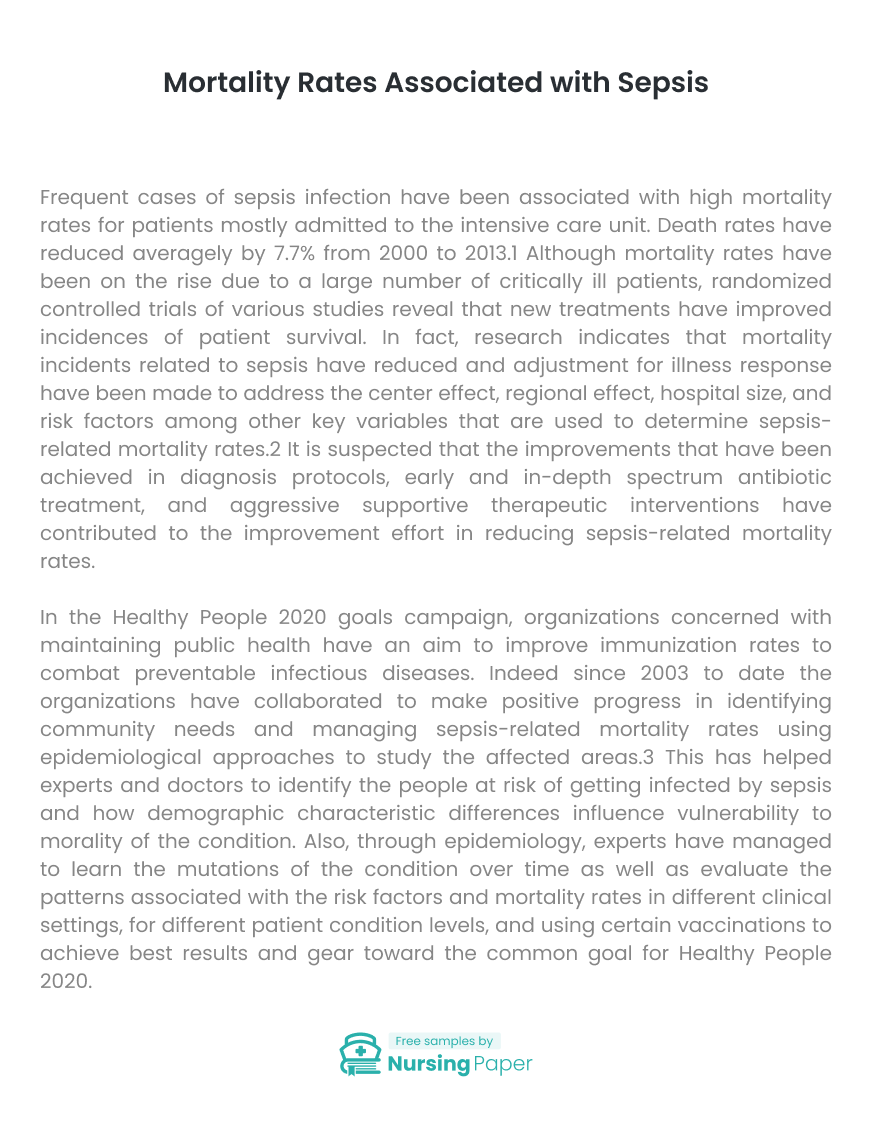
Mortality Rates Associated with Sepsis
Introduction
Frequent cases of sepsis infection have been associated with high mortality rates for patients mostly admitted to the intensive care unit. Death rates have reduced averagely by 7.7% from 2000 to 2013.1 Although mortality rates have been on the rise due to a large number of critically ill patients, randomized controlled trials of various studies reveal that new treatments have improved incidences of patient survival. In fact, research indicates that mortality incidents related to sepsis have reduced and adjustment for illness response have been made to address the center effect, regional effect, hospital size, and risk factors among other key variables that are used to determine sepsis-related mortality rates.2 It is suspected that the improvements that have been achieved in diagnosis protocols, early and in-depth spectrum antibiotic treatment, and aggressive supportive therapeutic interventions have contributed to the improvement effort in reducing sepsis-related mortality rates.
In the Healthy People 2020 goals campaign, organizations concerned with maintaining public health have an aim to improve immunization rates to combat preventable infectious diseases. Indeed since 2003 to date the organizations have collaborated to make positive progress in identifying community needs and managing sepsis-related mortality rates using epidemiological approaches to study the affected areas.3 This has helped experts and doctors to identify the people at risk of getting infected by sepsis and how demographic characteristic differences influence vulnerability to morality of the condition. Also, through epidemiology, experts have managed to learn the mutations of the condition over time as well as evaluate the patterns associated with the risk factors and mortality rates in different clinical settings, for different patient condition levels, and using certain vaccinations to achieve best results and gear toward the common goal for Healthy People 2020.


1. Fleischmann C. et al. Hospital incidence and mortality rates of sepsis: an analysis of hospital episode (DRG) statistics in Germany from 2007 to 2013. Deutsches Ärzteblatt International. 2016;113(10):159-166.
2. Kaukonen K. et al. Mortality related to severe sepsis and septic shock among critically ill patients in Australia and New Zealand, 2000-2012. Jama. 2014;311(13):1308-1316. doi:10.1001/jama.2014.2637.
3. Melamed A Frank JS. The burden of sepsis-associated mortality in the United States from 1999 to 2005: an analysis of multiple-cause-of-death data. Critical care. 2009;13(1): R28.



The download will start shortly.

The download will start shortly.
 Subject:
Nursing
Subject:
Nursing  Number of pages: 2
Number of pages: 2  Subject:
Nursing
Subject:
Nursing  Number of pages: 3
Number of pages: 3  Subject:
Nursing
Subject:
Nursing  Number of pages: 6
Number of pages: 6  Subject:
Medicine
Subject:
Medicine  Number of pages: 39
Number of pages: 39  Subject:
Medicine
Subject:
Medicine  Number of pages: 13
Number of pages: 13  Subject:
Nursing
Subject:
Nursing  Number of pages: 8
Number of pages: 8  Subject:
Nursing
Subject:
Nursing  Number of pages: 7
Number of pages: 7  Subject:
Nursing
Subject:
Nursing  Number of pages: 2
Number of pages: 2  Subject:
Medicine
Subject:
Medicine  Number of pages: 9
Number of pages: 9  Subject:
Health and Social Care
Subject:
Health and Social Care  Number of pages: 2
Number of pages: 2  Subject:
Health and Social Care
Subject:
Health and Social Care  Number of pages: 3
Number of pages: 3  Subject:
Medicine
Subject:
Medicine  Number of pages: 4
Number of pages: 4  Subject:
Medicine
Subject:
Medicine  Number of pages: 2
Number of pages: 2  Subject:
Medicine
Subject:
Medicine  Number of pages: 4
Number of pages: 4 
